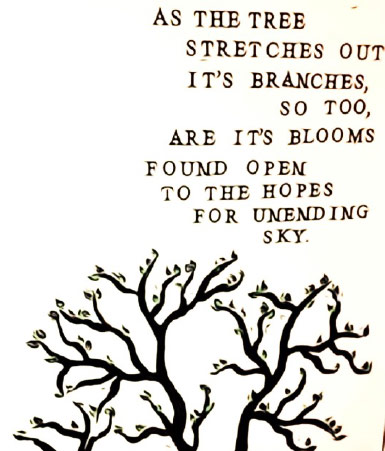Gardeners of the Children

Gardeners of the Children
For some time now, experts in working with children have held to the concept that we are wired for growth and healing, for self-righting and resuming impeded growth (Eigen, 1981; Ghent, 1990; Winnicott, 1960). Being wired for growth also means that we can adjust and adapt to an environment that is ever-changing.
When we think about our children, some of us caregivers presume that much of their behaviour is preprogrammed but neglect to take into consideration that they adapt according to the expressions and permissions we afford them.
Years ago, I wrote this poem on the door of my office [see accompanying picture] to remind myself that every person has potential and hopes to grow – in all directions – wherever their needs get met. And like a tree, we orient towards the sun (the nurturing source) and look for ways to gather resources which might create a sense of safety and security (roots) so that we may continue growing.
Some of the expressions and permissions caregivers provide are securing and developmentally appropriate. They give their children the chance to try out new roles such as emotional expression, managing themselves and others, and attuning to what others are experiencing and feeling. However, sometimes like a giant tree, we overshadow our little tree’s light source and true potentiation. When we monopolize the nurturing light source, and it invariably takes away the skills that a child needs to comfortably master and reach. It is important to explore the ways that you might be influencing the growth trajectory of your child and shaping their behaviour.
Therapists and counsellors can explore this with you and build a plan for how you might create (sticking with the analogy) light source potentials for your child, that will help them learn to reach their full potential. Lev Vygotsky (psychologist) suggested that caregivers sometimes slip out of proximity from what their child’s accurate developmental age might require (correct developmental zone), and in this way, it could impair the child’s chances of attaining opportunities for the growth of those skills. For example, if a caregiver will only throw ball with a child who can catch perfectly first time, they ever play ball. Or in other cases, a caregiver might only roll the ball, in fear, that the child will get hurt from throwing it. In either case, caregivers often mistake biological developmental age developmental age.
As a result, caregivers pressure children to grow in areas where no roots have been set or in environments where they are sure to falter and fail. As caregivers, it is through our own repulsions and aversions to growth areas our children must face, that triggers us and gets in the way. Sometimes the caregiver’s trauma can leave a blind-spot or deficit that makes it difficult to recognize or understand a child’s correct developmental zone and hold space for them to grow. We inevitably begin to shape where our children can grow.
Now, some caregivers might be thinking what I’m thinking. How do I expand the light source potentials for my child? The good news is that the brain has an innate ability to integrate new information into existing memory networks in a very adaptive way (Shapiro calls this Adaptive Information Processing, 2001a). We just need to be okay with now holding space for these new opportunities to develop. One trick that I have learned, is to remind myself to trust that my child’s brain is capable of handling it all. I just need to ensure that safety and my presence is considered.
From there, I can expose my child to opportunities to sit with emotional experiences, opportunities to manage me, and manage themselves (maybe even handle negative emotional experiences). I can even expose them different opinions so that they can learn to understand and empathize with the experiences of others.
An arborist friend of mine once told me that the creaks and wind pressure on a tree are part of the growth training of that tree. The roots adjust and the tree gains strength from the environmental tests it goes through. But remember, it is all developmental and fits within the correct developmental zone of that growing being’s experiential age. We are the gardeners of our children. And we can help them stretch, grown and creak along the way.

References:
Eigen, M. (1981). The area of faith in Winnicott, Lacan, and Bion. International Journal of Psychoanalysis, 62, 413-433.
Ghent, E. (1990/1999). Masochism, submission, surrender: masochism as a perversion of surrender. In: S. A. Mitchell and L. Aron (Eds.) (1999) Relational Psychoanalysis: The Emergence of a Tradition (pp. 211-242). Hillsdale, NJ: The Analytic Press.
Shapiro F. (2001a). Eye Movement Desensitization and Reprocessing – Basic Principles, Protocols, and Procedures. New York, NY: Guilford. Winnicott, D. W. (1960/1965). Ego distortion in terms of true and false self. In The maturational processes and the facilitating environment (pp. 140-152). New York: International Universities Press.
